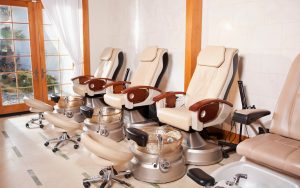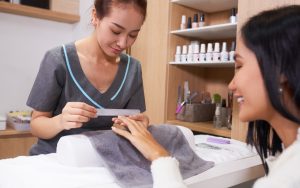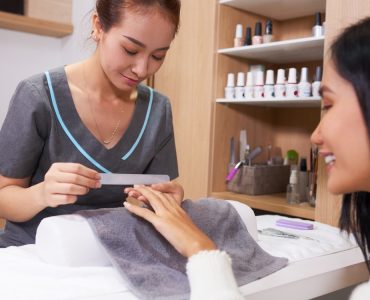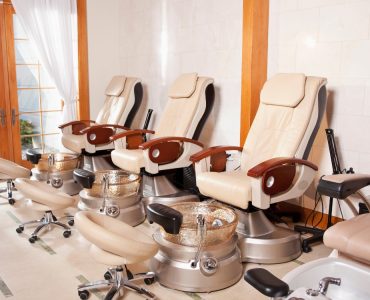A visit to the nail salon is often considered a relaxing and enjoyable experience, but have you ever stopped to think about the cleanliness and safety practices in place? Maintaining a high standard of hygiene and sanitation in nail salons is crucial not only for the well-being of the customers but also for the health of the nail technicians.

In this article, we will delve into why nail salon hygiene and sanitation should be a top priority, exploring the potential risks of poor practices and highlighting the measures that should be taken to ensure a safe and clean environment. So let’s dive in and discover the significance of maintaining proper hygiene and sanitation in nail salons.
Fungal Infections: The Hidden Dangers Lurking in Nail Salons
When you step into a nail salon, you expect a relaxing and pampering experience. However, beneath the surface of polished nails and soothing treatments, there are hidden dangers that often go unnoticed: fungal infections.
These insidious infections can have long-lasting effects on your health if proper hygiene practices are not followed in nail salons. In this section, we will delve into the alarming risks associated with fungal infections and why nail salon hygiene should be your top concern.
The Prevalence of Fungal Infections
Fungal infections, such as onychomycosis (nail fungus), are more common than you might think. Nail salons provide the perfect breeding ground for fungi due to the warm and moist environment created by foot baths, damp towels, and the presence of multiple clients. Without strict hygiene practices, fungal spores can easily spread from one customer to another, putting everyone at risk.
The Risks and Symptoms
Fungal infections can wreak havoc on your nails, causing them to become discolored, thickened, brittle, or even separate from the nail bed. However, the risks extend beyond cosmetic concerns. If left untreated, fungal infections can lead to painful nail bed inflammations and secondary bacterial infections. People with compromised immune systems or underlying health conditions are particularly vulnerable to severe complications.
Unsanitary Practices and Fungal Transmission
Inadequate hygiene practices in nail salons significantly contribute to the spread of fungal infections. Reusing tools without proper sterilization, using contaminated foot baths, and failing to disinfect surfaces can create a breeding ground for fungi. Additionally, the improper handling and storage of nail products can lead to contamination, posing a risk to unsuspecting customers.
The Importance of Sterilization and Sanitation
To protect yourself from fungal infections, it is crucial to choose a nail salon that prioritizes hygiene. Look for salons that use hospital-grade disinfectants to clean their tools, including nail clippers, files, and foot bath basins. Sterilization techniques, such as autoclaving, should be employed to ensure the complete eradication of fungi and other harmful microorganisms.
Education and Awareness
As a customer, it’s essential to be aware of the risks and take necessary precautions. Pay attention to the cleanliness of the salon, observe how the technicians handle their tools, and inquire about their sanitation practices.
Educate yourself about the signs and symptoms of fungal infections, and don’t hesitate to seek medical attention if you suspect an infection. By being proactive and informed, you can protect yourself from the hidden dangers lurking in nail salons.
Read This Next:
Bacterial Infections: Protect Yourself from Harmful Germs
While a trip to the nail salon is often seen as a luxurious treat, it’s essential to be aware of the potential risks that can lurk beneath the shiny surfaces. Among these risks are bacterial infections, which can pose serious threats to your health if proper hygiene measures are not followed.
In this section, we will explore the alarming world of bacterial infections and why prioritizing nail salon hygiene is crucial to protect yourself from harmful germs.
Common Bacterial Infections
Bacterial infections in nail salons can manifest in various forms, including paronychia (infection around the nail), cellulitis (skin infection), and even more severe conditions like staph infections. These infections can cause redness, swelling, pain, and pus formation, leading to discomfort and potential complications if left untreated. It’s alarming how easily bacteria can find their way into the salon environment and transfer from one customer to another.
Unsanitary Tools and Surfaces
One of the primary sources of bacterial infections in nail salons is the improper handling and cleaning of tools. When tools are not thoroughly sanitized between clients, harmful bacteria can be transmitted.
Nail clippers, cuticle nippers, and other implements can harbor bacteria and serve as a pathway for infection. Additionally, inadequately cleaned surfaces and workstations can become breeding grounds for harmful germs, putting both customers and nail technicians at risk.
The Role of Foot Baths
Foot baths may seem like a relaxing and luxurious part of the nail salon experience, but they can also be potential hotspots for bacterial contamination. If foot baths are not adequately cleaned and disinfected between clients, bacteria can thrive and transfer to the feet and legs of subsequent customers. It’s crucial for nail salons to implement proper cleaning protocols for foot baths to prevent the spread of bacteria and maintain a safe environment.
The Importance of Hand Hygiene
In addition to the salon’s responsibility to maintain cleanliness, hand hygiene plays a vital role in preventing bacterial infections. Nail technicians should wash their hands thoroughly before and after each client, using antibacterial soap and warm water.
They should also use hand sanitizers or wear disposable gloves when appropriate. Likewise, customers should practice good hand hygiene by washing their hands before and after their salon visit.
Promoting Proper Sanitation Practices
To protect yourself from bacterial infections, it’s crucial to choose a nail salon that prioritizes sanitation. Look for salons that use hospital-grade disinfectants to clean their tools, regularly sterilize their implements, and follow strict hygiene protocols.
Don’t hesitate to ask questions about their sanitation practices and observe how the technicians handle and clean their tools. By selecting salons that adhere to high sanitation standards, you can minimize the risk of bacterial infections.
Read This Next:
Viral Infections: Don’t Gamble with Your Health
When it comes to nail salon hygiene, the focus is not limited to bacterial and fungal infections alone. Viral infections also pose a significant threat to your health if proper sanitation practices are not followed. In this section, we will delve into the world of viral infections and why it’s crucial not to gamble with your health when it comes to nail salon hygiene.
Common Viral Infections
Nail salons can potentially be hotspots for the transmission of various viral infections. Some of the most concerning viruses include herpes simplex virus (HSV), human papillomavirus (HPV), and even bloodborne viruses such as hepatitis B and C. These viruses can be easily transmitted through skin-to-skin contact, contaminated tools, or exposure to infected bodily fluids, presenting serious health risks.
The Role of Hygiene in Viral Prevention
Maintaining proper hygiene practices in nail salons is essential to prevent the spread of viral infections. Adequate hand hygiene, including frequent handwashing and the use of hand sanitizers, helps reduce the risk of viral transmission.
It is also crucial for nail technicians to follow proper sanitation protocols, including the disinfection of tools, equipment, and surfaces between clients, to minimize the chances of viral contamination.
Importance of Clean and Virus-Free Environment
Creating a clean and virus-free environment in nail salons is paramount for the safety of both customers and nail technicians. Proper ventilation systems help improve air quality and reduce the concentration of airborne viruses. Regular cleaning and disinfection of surfaces, including waiting areas, nail stations, and foot baths, are essential to prevent the accumulation and spread of viral particles.
Educating Nail Technicians and Customers
Education and awareness play a crucial role in preventing viral infections in nail salons. Nail technicians should receive training on proper sanitation practices, including the identification and prevention of viral transmission. Customers also need to be informed about the risks and precautions they should take when visiting nail salons. By empowering both technicians and customers with knowledge, we can collectively work towards creating safer salon environments.
Promoting Safe Practices and Protocols
To protect yourself from viral infections, it’s essential to choose nail salons that prioritize safe practices and adhere to proper protocols. Look for salons that have clearly visible hygiene measures in place, such as frequent handwashing, disinfection of tools, and a clean environment. Consider salons that use single-use disposable items whenever possible to further minimize the risk of viral transmission.
Chemical Hazards: Protecting Your Nails and Overall Well-being
While the focus on nail salon hygiene often revolves around infections, it’s essential not to overlook the potential hazards posed by the chemicals used in nail products. From nail polishes to acrylics, these products can contain harmful chemicals that can negatively impact your nails and overall well-being. In this section, we will explore the importance of protecting yourself from chemical hazards in nail salons.
Understanding Harmful Chemicals in Nail Products
Nail products commonly contain chemicals such as formaldehyde, toluene, dibutyl phthalate (DBP), and ethyl methacrylate (EMA). These chemicals can have various adverse effects on your nails and health. Formaldehyde, for instance, is a known carcinogen and can cause allergic reactions. Toluene has been linked to respiratory issues and can harm the nervous system. DBP is a potential endocrine disruptor, and EMA can cause skin irritation and allergic reactions.
Nail Salons and Occupational Exposure
Nail technicians are particularly vulnerable to chemical hazards due to their prolonged and frequent exposure to nail products. Continuous exposure to these chemicals without proper ventilation or protective measures can lead to health issues. Nail salon owners have a responsibility to provide a safe working environment, including adequate ventilation systems and the use of less toxic or non-toxic nail products.
Read This Next:
Protecting Your Nails
Protecting your nails from chemical hazards starts with making informed choices. Opt for nail salons that offer a wide range of non-toxic and eco-friendly nail products. These products are formulated without harmful chemicals, reducing the risks of nail damage and adverse health effects. Additionally, taking breaks between manicures and pedicures can allow your nails to breathe and recover from potential chemical exposure.
Promoting Safer Nail Products
As consumers, we can play a role in encouraging the use of safer nail products in salons. By supporting nail salons that prioritize the use of non-toxic and low-chemical products, we send a message that the well-being of both customers and nail technicians is a top priority. Increased demand for safer alternatives can drive the industry towards adopting healthier practices.
Support for Healthier Salon Environments
Encourage nail salon owners to provide proper ventilation systems that effectively remove harmful fumes from the air. Urge them to train their staff on the safe use of nail products and the importance of using personal protective equipment. By advocating for better practices, we can contribute to a safer and healthier nail salon industry.
Occupational Safety: The Well-being of Nail Technicians
In the discussion of nail salon hygiene, it’s crucial to address the occupational safety and well-being of nail technicians. These professionals are on the front lines, working with various products and tools that can pose risks to their health if proper safety measures are not in place. In this section, we will delve into the importance of occupational safety and the well-being of nail technicians.
Occupational Hazards in Nail Salons
Nail technicians face numerous occupational hazards that can impact their physical health and overall well-being. Prolonged exposure to chemical fumes from nail products can lead to respiratory issues and skin irritations. Repetitive tasks, such as filing and shaping nails, can result in musculoskeletal disorders, including carpal tunnel syndrome. Additionally, prolonged standing can lead to foot and back problems. It’s crucial to address these hazards and prioritize the safety of nail technicians.
Proper Ventilation and Air Quality
A key aspect of occupational safety for nail technicians is maintaining proper ventilation and air quality in the salon. Adequate ventilation systems, such as exhaust fans and air purifiers, help remove chemical fumes and maintain a healthier work environment. This reduces the risk of respiratory issues and ensures better overall air quality for both technicians and customers.
Safe Handling of Chemicals
Nail technicians should receive proper training on the safe handling of chemicals used in nail products. This includes understanding the potential risks associated with different ingredients and following guidelines for their safe use. The use of personal protective equipment, such as gloves and masks, can provide an additional layer of protection against chemical exposure.
Ergonomics and Workstation Design
Creating ergonomic workstations is crucial to prevent musculoskeletal disorders and promote the well-being of nail technicians. Adjustable chairs and ergonomic tools can help reduce the strain on their bodies during prolonged periods of work. Proper posture, regular breaks, and stretching exercises can also contribute to maintaining good physical health and preventing work-related injuries.
Education and Empowerment
Education plays a significant role in ensuring the occupational safety of nail technicians. Salons should provide comprehensive training on safety protocols, hazard identification, and proper use of equipment. Nail technicians should feel empowered to voice concerns and seek necessary support to maintain a safe and healthy working environment.
Advocacy for Occupational Safety
Advocacy is vital in promoting the well-being of nail technicians. Encourage salon owners to prioritize the safety and health of their employees by implementing safety protocols, providing training, and offering ergonomic workstations. By supporting initiatives that advocate for better occupational safety standards, we can contribute to a more sustainable and healthy nail salon industry.
Conclusion
In conclusion, the importance of nail salon hygiene and sanitation cannot be overstated. By implementing stringent cleanliness protocols and maintaining a safe environment, nail salons can protect the health and well-being of their customers and staff. From proper disinfection of tools and equipment to regular hand hygiene and adequate ventilation, every aspect of maintaining a clean and sanitary environment plays a crucial role. Customers should also be aware of the practices and standards they should expect from a nail salon, and not hesitate to speak up if they notice any lapses in hygiene.








